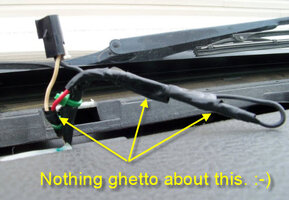What started as doing another member a favor by measuring a resistor that I had used for auto light killing resulted in me ripping the lead out of the resistor....since I had to do it again, here's some pics.
Light sensor plugged in, uncovered

Light sensor plugged in, covered (note: I didn't wait the 1 minute for it to turn the lights on, hence the 0% low beam duty cycle)

Light sensor unplugged

The resistor that I had got from BO TIE SS was 100 ohm and worked as intended. Unfortunately, I didn't have anything close on hand, so I tried a 1200 ohm.

I put the resistor in place of the light sensor (of course, this is temporary for testing purposes only, shoving resistors into connectors is straight up ghetto)

This pulled the sensor voltage at the BCM to 2.7v, and the autolights turned off

I made a mini loop with the resistor inside.....

....and tied it into the sensor wiring like the previous one was. The sensor does not get plugged back in.

So, I can confirm that any resistor between 100 and 1200 ohms will work for doing this.
All credit goes to BO TIE SS since I learned about this from him.
Light sensor plugged in, uncovered

Light sensor plugged in, covered (note: I didn't wait the 1 minute for it to turn the lights on, hence the 0% low beam duty cycle)

Light sensor unplugged

The resistor that I had got from BO TIE SS was 100 ohm and worked as intended. Unfortunately, I didn't have anything close on hand, so I tried a 1200 ohm.

I put the resistor in place of the light sensor (of course, this is temporary for testing purposes only, shoving resistors into connectors is straight up ghetto)

This pulled the sensor voltage at the BCM to 2.7v, and the autolights turned off

I made a mini loop with the resistor inside.....

....and tied it into the sensor wiring like the previous one was. The sensor does not get plugged back in.

So, I can confirm that any resistor between 100 and 1200 ohms will work for doing this.
All credit goes to BO TIE SS since I learned about this from him.






